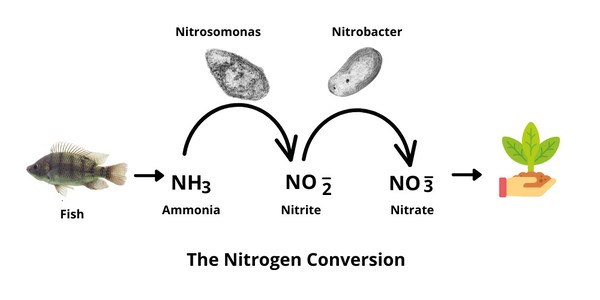An aquaponics system is considered functional and established once system cycling is done, the nitrifying bacteria is established, and there are no signs of fish stress and plants' nutrient deficiencies. One crucial factor that has a vital role in aquaponics system cycling is nitrates.
Nitrates are a non-toxic form of nitrogen used in the formation of plants cells and fish health. However, too high nitrates concentrations can lead to uncontrolled plants' growth and nitrates accumulation in plant leaves which is dangerous to human health. So it is important that every aquaponics grower must understand the importance of nitrates, the nitrification process, the ideal nitrates level, and how to monitor and adjust nitrates levels in aquaponics systems.
What is Nitrates?
Nitrates are a less toxic form of nitrogen, which is food for your aquaponics plants. In other words, they are good for aquaponics. However, excess nitrates can lead to methane gas production, algae growth, and high acid water content. Therefore, you need to keep a balance between the biomass of fish and the number of plants in the grow bed to ensure there is no overproduction of nitrates in your system.
The Nitrogen Cycle and Nitrification Process
The nitrogen cycle is an essential biological process in aquaponics. It begins when the fish feed is fed into the fish in the system. The fish feed is rich in protein, which the nitrogen cycle will break down into nitrogen.
Below is a detailed explanation of how nitrates are produced in aquaponics:
- The first process of the nitrogen cycle begins when protein-rich fish feed enters the system. Fish eat the fish feed and excrete it back into the system in the form of ammonia.
- As fish excrete ammonia, the nitrifying bacteria (Nitrosomonas) present in the biofilter converts ammonia into nitrites.
- In the second process of the nitrogen cycle, the nitrifying bacteria (Nitrobacter) converts nitrites into nitrates.

The Importance Of Nitrates in Aquaponics
Understanding the importance of nitrates in aquaponics is essential in ensuring continuous cycling for fish and plant development. Plants in the grow bed use nitrates to produce protein and amino acids to thrive and achieve maximum yield.
Below are the key roles of nitrates in an aquaponics system:
- Nitrogen is necessary for fish and plant growth. It is a key component of amino acids, proteins, and nucleic acids.
- The formation of nitrates through nitrification reduces the concentration of toxic ammonia excreted by the fish.
- Nitrates are necessary for plant growth.
- Nitrogen is an ingredient of chlorophyll that plants an essential role in plants' photosynthesis.
The Ideal Nitrate Level for Aquaponics
Even though nitrates are essential in aquaponics systems, it needs to be monitored and kept to their ideal level. Too high nitrates level can lead to problems in your system. Experts' opinions differ on the ideal nitrates level for aquaponics systems. However, the most recommended ideal level is between 3 to 150 mg per liter or 150 ppm.
Although some fish can tolerate higher levels of nitrates (300 to 400 mg), it is better to follow the ideal level to avoid higher nitrates concentrations in the leaves of the plants.
How to Monitor Nitrate Levels in Aquaponics
To monitor the nitrates level of your aquaponics system, you can use a six-in-one test strip available online and in your local aquaponics shop.
This test strip can also measure the pH, hardness, nitrite, and alkalinity of the water. Monitoring should be done every two or three days. It is also essential to remember that your system may not have many nitrites or nitrates if it is new as the bacteria have not yet developed and multiplied. However, it will rise eventually when the bacterial population in your system grows.

How to Adjust Nitrate Levels in Aquaponics
There are several methods of adjusting too low or too high nitrates levels in the system. Keep in mind that every aquaponics system is different, so before adjusting, check first the ammonia, nitrites, and nitrates levels to ensure you're making the most informed decision possible.
If your nitrates are low, despite having completed the cycling process, try the following methods:
1. Add more fish: If your nitrates are low and do not have excess ammonia or nitrites in them, then the problem is there are not enough fish in the system to produce ammonia for the bacteria to convert into nitrates.
2. Add more bacteria: If you have excess ammonia but still have low nitrates, the problem is a lack of Nitrosomonas bacteria. You can fix this by adding more bacteria into the system. This will allow the ammonia to be converted into nitrites and nitrates.
If your system has excess nitrate, you can adjust it by following the methods below:
1. Adding more plants: adding more plants will help lower the level of nitrates in the system as the plant's roots will absorb nitrates.
2. Removing fish: If you have too many fish in the system, it will produce more ammonia, leading to higher nitrates levels. To fix this problem, simply remove some fish in the fish tank. Keep in mind the fish to plant ratio.
3. Changing some of the water: Remove at least 15-20% of the water from the fish tank and replace it with dechlorinated water. This will help lower the nitrates level into the ideal range.
Conclusion
Every aquaponics system is different, and each of the options mentioned above has pros and cons. For example, adding some plants to your system will increase your plant yield, but it may also decrease the level of other micronutrients. The best thing you can do to fix nitrates problems is to check the pH, ammonia, and nitrites levels. Then choose one of the first two methods in adjusting nitrates and change some of the water in the fish tank.






Leave a comment (all fields required)